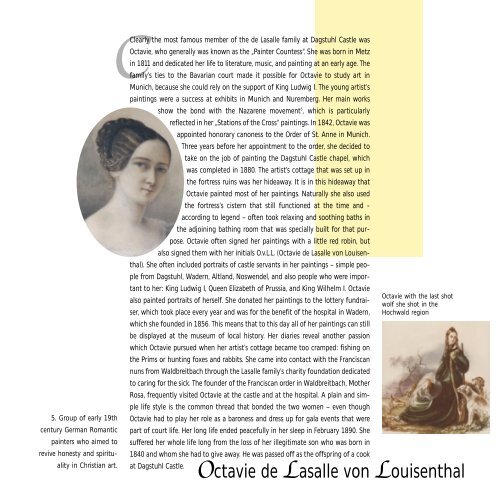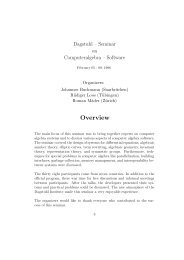Castle Dagstuhl - Schloss Dagstuhl
Castle Dagstuhl - Schloss Dagstuhl
Castle Dagstuhl - Schloss Dagstuhl
You also want an ePaper? Increase the reach of your titles
YUMPU automatically turns print PDFs into web optimized ePapers that Google loves.
5. Group of early 19th<br />
century German Romantic<br />
painters who aimed to<br />
revive honesty and spirituality<br />
in Christian art.<br />
Clearly the most famous member of the de Lasalle family at <strong>Dagstuhl</strong> <strong>Castle</strong> was<br />
Octavie, who generally was known as the „Painter Countess“. She was born in Metz<br />
in 1811 and dedicated her life to literature, music, and painting at an early age. The<br />
family’s ties to the Bavarian court made it possible for Octavie to study art in<br />
Munich, because she could rely on the support of King Ludwig I. The young artist’s<br />
paintings were a success at exhibits in Munich and Nuremberg. Her main works<br />
show the bond with the Nazarene movement5 , which is particularly<br />
reflected in her „Stations of the Cross“ paintings. In 1842, Octavie was<br />
appointed honorary canoness to the Order of St. Anne in Munich.<br />
Three years before her appointment to the order, she decided to<br />
take on the job of painting the <strong>Dagstuhl</strong> <strong>Castle</strong> chapel, which<br />
was completed in 1880. The artist’s cottage that was set up in<br />
the fortress ruins was her hideaway. It is in this hideaway that<br />
Octavie painted most of her paintings. Naturally she also used<br />
the fortress’s cistern that still functioned at the time and -<br />
according to legend – often took relaxing and soothing baths in<br />
the adjoining bathing room that was specially built for that purpose.<br />
Octavie often signed her paintings with a little red robin, but<br />
also signed them with her initials O.v.L.L. (Octavie de Lasalle von Louisenthal).<br />
She often included portraits of castle servants in her paintings – simple people<br />
from <strong>Dagstuhl</strong>, Wadern, Altland, Noswendel, and also people who were important<br />
to her: King Ludwig I, Queen Elizabeth of Prussia, and King Wilhelm I. Octavie<br />
also painted portraits of herself. She donated her paintings to the lottery fundraiser,<br />
which took place every year and was for the benefit of the hospital in Wadern,<br />
which she founded in 1856. This means that to this day all of her paintings can still<br />
be displayed at the museum of local history. Her diaries reveal another passion<br />
which Octavie pursued when her artist’s cottage became too cramped: fishing on<br />
the Prims or hunting foxes and rabbits. She came into contact with the Franciscan<br />
nuns from Waldbreitbach through the Lasalle family’s charity foundation dedicated<br />
to caring for the sick. The founder of the Franciscan order in Waldbreitbach, Mother<br />
Rosa, frequently visited Octavie at the castle and at the hospital. A plain and simple<br />
life style is the common thread that bonded the two women – even though<br />
Octavie had to play her role as a baroness and dress up for gala events that were<br />
part of court life. Her long life ended peacefully in her sleep in February 1890. She<br />
suffered her whole life long from the loss of her illegitimate son who was born in<br />
Octavie with the last shot<br />
wolf she shot in the<br />
Hochwald region<br />
1840 and whom she had to give away. He was passed off as the offspring of a cook<br />
at <strong>Dagstuhl</strong> <strong>Castle</strong>. Octavie de Lasalle von Louisenthal





